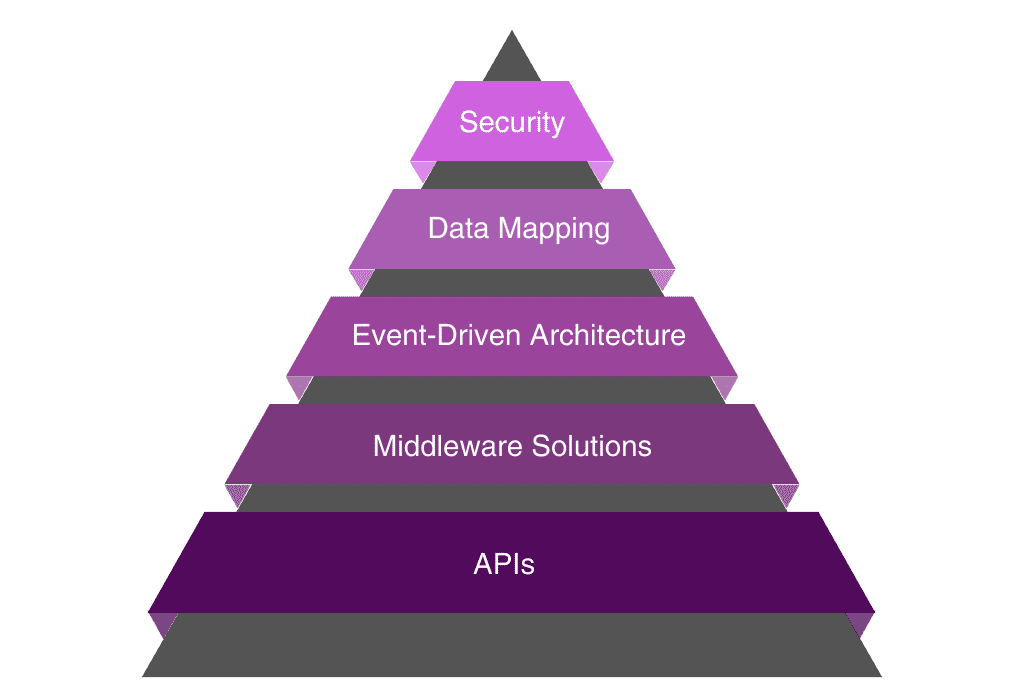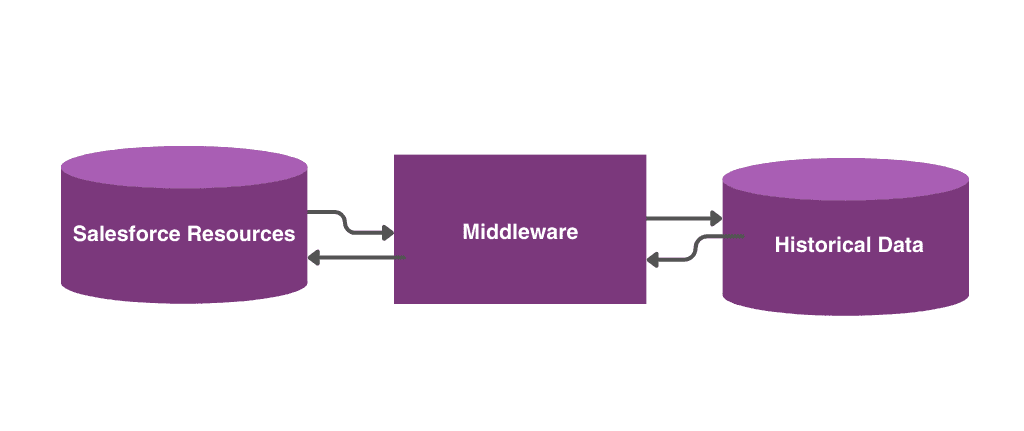Salesforce has established itself as a leading CRM platform, with over 150,000 companies using it to streamline their operations. However, the true power of Salesforce is only unlocked when it is integrated with other systems within an organization. This is where a Salesforce Integration Consultant becomes invaluable. Moreover, a report by HubSpot found that 57% of salespeople rely on CRM data to close deals effectively, underlining the importance of integrated systems for business success. This highlights the crucial role of a Salesforce Integration Consultant.
In this detailed guide outlining the importance and role of a Salesforce Integration Consultant, we will explore the following:
- What is Salesforce Integration?
- Who is a Salesforce Consultant?
- Key Components of Successful Integration in Salesforce
- How Consultants Implement Salesforce Integration?
- Benefits of Salesforce Integration Consulting
- Types of Salesforce Integration Solutions
- Process That Our Salesforce Integration Company Follows
Don’t let siloed systems hold your business back. Elevate your efficiency with expert Salesforce integration solutions.
What is Salesforce Integration?
Salesforce integration involves connecting the Salesforce platform with other systems and applications within an organization. This integration ensures that data flows seamlessly between Salesforce and other software, enabling a unified view of customer information and operational data. For instance, integrating Salesforce with an ERP system can streamline order processing and inventory management, making it easier to track customer orders and manage stocks effectively.
Who is a Salesforce Integration Consultant?
A Salesforce Integration Consultant is a specialized professional with expertise connecting Salesforce with other business systems. They possess a mix of technical skills, including understanding APIs and middleware, and business acumen to ensure the integration aligns with organizational goals.

What are the Key Components of Successful Integration Frameworks in Salesforce?
Successful Salesforce integration relies on a robust framework that ensures data consistency, security, and efficiency. Here are the key components:
1. APIs are the foundation of integration frameworks
Application Programming Interfaces (APIs) are the backbone of any integration framework, enabling different systems to communicate and exchange data seamlessly. Salesforce offers various APIs, such as REST API, SOAP API, and Bulk API, each catering to specific integration needs. For example, the REST API is ideal for real-time data exchange, while the Bulk API is designed for handling large data volumes efficiently.
2. Middleware solutions bridge the gap between systems
Middleware solutions often include features like data transformation, error handling, and transaction management. For instance, MuleSoft’s Anypoint Platform provides a visual interface for designing integration workflows, allowing consultants to map data fields, apply transformation rules, and configure error-handling mechanisms.
3. Event-driven architecture helps in building solutions
Event-driven architecture (EDA) is a design pattern that enables systems to respond to events in real time. In the context of Salesforce integration, EDA allows systems to react to changes in Salesforce data, such as new records, updates, or deletions. This approach improves responsiveness and ensures data consistency across integrated systems.
4. Data mapping ensures consistency during data exchange
Data mapping involves defining how data fields in one system correspond to fields in another system. This step is crucial for maintaining data consistency and accuracy during integration. Salesforce integration consultants use data mapping tools to create transformation rules, ensuring that data is correctly formatted and interpreted by the target system.
5. Security and authentication authorizes access to Salesforce data
Security and authentication are paramount in any integration project sensitive data and ensure compliance with regulatory requirements. Salesforce offers various security mechanisms, such as OAuth 2.0, Single Sign-On (SSO), and IP whitelisting, to control access to its APIs and data.

Components of Successful Salesforce Integration Frameworks
Your Success Story Starts Here! Master Salesforce Integration With Our Expert Integration Services!
How Consultants Implement Salesforce Integration?
Implementing Salesforce integration involves several steps, each requiring careful planning and execution. Here is a high-level overview of the process:
1. Define Integration Requirements
Identify the systems to be integrated, the data to be exchanged, and the specific business processes to be automated.
2. Choose the right integration approach
Select the appropriate integration approach based on the complexity and requirements of the integration. Common approaches include point-to-point integration, middleware-based integration, and event-driven integration.
3. Develop Integration Logic
Develop the integration logic using Salesforce APIs, middleware solutions, and data mapping tools. Ensure that data transformation and validations are properly implemented.
4. Test the Integration
Thoroughly test the integration to identify and resolve any issues. Conduct integration testing, performance testing, and security testing to ensure the integration meets the desired standards.
5. Deploy and Monitor
Deploy the integration to the production environment and continuously monitor its performance. Implement monitoring tools and alert mechanisms to detect and address any issues promptly.
Benefits of Salesforce Integration Consulting
Engaging a Salesforce Integration Consultant offers several benefits for business:
1. Expertise and Experience
Consultants bring specialized knowledge and experience in Salesforce integration, ensuring that best practices are followed, and common pitfalls are avoided.
2. Tailored Solutions
Consultants work closely with businesses to understand their unique requirements and provide customized integration solutions that align with their goals.
3. Faster-Time-to-market
With their expertise, consultants can accelerate the integration process, reducing the time it takes to achieve a fully integrated system.
4. Improved data accuracy
Consultants ensure that data is accurately mapped and transformed, minimizing the risk of data discrepancies and improving overall data quality.
5. Cost savings
By optimizing the integration process and reusing errors, consultants help businesses save costs associated with manual data handling and system inefficiencies.
Let our Salesforce integration consultants streamline your operations, ensuring your systems are ready for tomorrow’s challenges.
Types of Salesforce Integration Solutions Used By Consultants
Salesforce integration can be categorized into several types based on the integration approach and use case:
1. Point-to-Point Integration
Point-to-point integration involves directly connecting Salesforce with another system using APIs. This approach is suitable for simple, one-to-one integrations where data needs to be transferred between two systems without intermediary steps. However, as the number of integrations increases, managing these direct connections can become complex and difficult, leading to a potential “spaghetti” architecture that is hard to maintain and troubleshoot.

2. Middleware-based integration
Middleware-based integration uses intermediary platforms like MulSoft, Dell Bomi, or Jitterbit to connect Salesforce with multiple systems. Middleware acts as a bridge, providing a centralized platform for managing integrations. This approach offers greater flexibility and scalability, making handling complex integrations involving multiple systems easier. Middleware solutions often come with built-in connectors and transformation tools, simplifying the process of data mapping and ensuring that data is accurately and efficiently transferred between systems.

3. Event-driven integration
Event-driven integration leverages Salesforce’s event-based architecture to trigger actions in other systems based on events in Salesforce. For example, an event such as creating a new customer record in Salesforce can trigger an update in an ERP system. This approach is ideal for real-time data synchronization and responsive integration scenarios where immediate action is required. Event-driven integrations enable systems to communicate and react to changes as they happen, ensuring data consistency and operational agility.

4. ETL (Extract, Transform, Load) Integration
ETL integration involves extracting data from one system, transforming it to match the target system’s schema, and loading it into the target system. Tools like Talend and Informatica are commonly used for ETL-based integrations. These tools provide robust data transformation and validation capabilities, ensuring that data is accurately and consistently transferred between systems. ETL processes are particularly useful for batch data processing, where large volumes of data need to be moved and transformed on a regular schedule.

5. Custom Integration
Custom integration involves developing solutions tailored to your specific business needs. This approach is suitable for unique integration scenarios that cannot be addressed by standard tools and platforms. Custom integrations often involve developing custom APIs, connectors, and data transformation scripts to meet specific requirements. While this approach can be more time-consuming and resource-intensive, it allows for a high degree of customization and control, ensuring that the integration meets the exact needs of the business.

Process That Our Salesforce Integration Company Follows
At Plumlogix, we follow a structured process to ensure successful Salesforce integration projects for our clients:
1. Requirement Analysis
Before starting any integration project, we ensure that clear objectives are established. This involves understanding the specific business needs and goals that the integration aims to achieve.
2. Comprehensive Data Mapping
We perform comprehensive data mapping to ensure that data from various sources accurately aligns with the corresponding fields in Salesforce. This step is crucial for maintaining consistency across the integrated systems.
3. Testing and Validation
Thorough testing and validation are conducted to ensure that the integrated systems function correctly and meet the specified requirements. This includes both individual component testing as well as end-to-end testing to verify the overall system functionality.
4. Deployment and Go-Live
Once testing is completed, the integration solution is deployed to the production environment. We carefully plan and execute the deployment process to minimize disruption to ongoing business operations. After deployment, we monitor the integrated systems closely during the initial period to address any unexpected issues that may arise.
5. Post-Implementation Support
Our support extends beyond the deployment phase. We provide post-implementation support to address any post-deployment issues, fine-tune the integration as needed, and ensure that the integrated systems continue to operate smoothly. Our goal is to ensure that the integration delivers sustained value to the business.
About Plumlogix – Your Trusted Salesforce Integration Consultant
As a leading digital transformation company and a certified Salesforce Partner, Plumlogix is dedicated to empowering businesses with advanced integration solutions that drive growth and success.
Here are the reasons why you should choose Plumlogix as your go-to partner for successful Salesforce integration services::
- Expertise in Salesforce Integration: Plumlogix excels in integrating Salesforce solutions, providing businesses with the tools to streamline operations and stay competitive.
- Innovative AI Solutions: By leveraging AI technologies, Plumlogix modernizes business operations, driving continuous innovation and scalability.
- Managed Services: Their top-notch managed services help businesses transition from outdated processes to efficient, future-ready operations.
- Sector-Specific Experience: With extensive experience in manufacturing, education, non-profit, and retail sectors, Plumlogix delivers tailored solutions that address unique industry challenges.
- Operational Efficiency: Plumlogix’s expertise ensures improved operational efficiency, enabling businesses to achieve their digital transformation goals.
- Customer Satisfaction: Their customer-centric approach focuses on boosting satisfaction and delivering measurable results.
Conclusion
In conclusion, integrating Salesforce with other systems is crucial for businesses to streamline their operations and achieve a unified view of customer information and operational data. A Salesforce Integration Consultant plays a vital role in designing, implementing, and maintaining these integrations to ensure data consistency, security, and efficiency. By leveraging APIs, middleware solutions, event-driven architecture, and data mapping, businesses can optimize their Salesforce integration to meet their specific needs and drive overall success. If you have further questions about Salesforce integration, feel free to reach out to us for more information.







